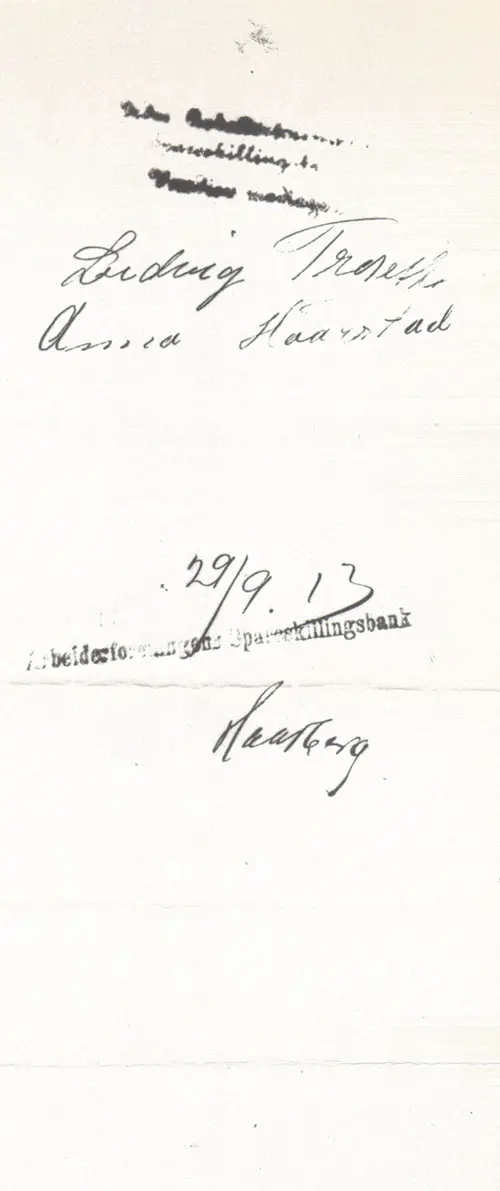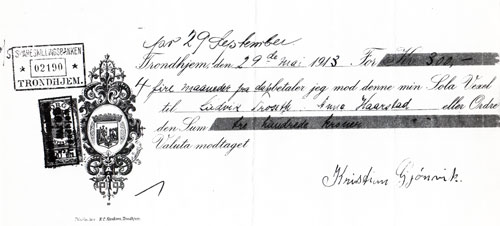Norwegian Bank Note - Loan for Immigrant to U.S. - 1913
Copy of front (above) and backside (below) of note payable Spareskillingsbanken, Trondhjem, Norway. The Troseths advanced Ludvig's funds (signed for the bank loan) to immigrate to the United States. GGA Image ID # 1fa8f0e5bf (Front) and GGA Image ID # 1fa8f8feb6 (Back)

Example of a Norwegian Bank Note from Spareskillingsbanken Trondhjem dated 24 May 1913 that was used to fund the expense of traveling from Norway to the United States by a Norwegian Immigrant.
The under-class citizens of Norway often had help from relatives in Norway or the United States to help pay for Passage to the U.S. Saving up the equivalent of about three months' wages for a common laborer would have seemed daunting.
Note Payable dated 29.05.1913 for Kr.300 (approximately US$ 50) that Ludvig Kristian Gjønvik received from Ludvik Troseth and Anna Haarstad, relatives in Trondhjem, who helped him. Ludvig purchased the steamship ticket from Trondhjem to Boston with the proceeds. The note was payable in 4 months (29.09.1913) with no stated interest. According to Arvid Gjønvik, the loan was repaid as agreed.
In 2022, the relative values of $50.00 from 1913 ranges from $1,100.00 to $32,200.00.
A simple Purchasing Power Calculator would say the relative value is $1,520.00. This answer is obtained by multiplying $50 by the percentage increase in the CPI from 1913 to 2022.
This may not be the best answer.
The best measure of the relative value over time depends on whether you want to compare the cost or value of a Commodity, Income, Wealth, or Project.
If you want to compare the value of a $50.00 Commodity in 1913, there are four choices. In 2022, the relative:
- The real price of that commodity is $1,520.00
- The real value in consumption of that commodity is $3,270.00
- Labor value of that commodity is $7,190.00 (using the unskilled wage) or $8,820.00 (using production worker compensation)
- The income value of that commodity is $9,390.00
- The economic share of that commodity is $32,200.00
If you want to compare the value of a $50.00 Income or Wealth in 1913, there are five choices. In 2022, the relative:
- The real wage or real wealth value of that income or wealth is $1,520.00
- Household purchasing power value of that income or wealth is $3,270.00
- Relative labor earnings of that commodity are $7,190.00 (using the unskilled wage) or $8,820.00 (using production worker compensation)
- The relative income or wealth value of that income or wealth is $9,390.00
- The relative output value of that income or wealth is $32,200.00
If you want to compare the value of a $50.00 Project in 1913, there are four choices. In 2022, the relative:
- The real cost of that project is $1,100.00
- The household cost of that project is $3,270.00
- Labor cost of that project is $7,190.00 (using the unskilled wage) or $8,820.00 (using production worker compensation)
- The relative cost of that project is $9,390.00
- The economic cost of that project is $32,200.00
Samuel H. Williamson, "Seven Ways to Compute the Relative Value of a U.S. Dollar Amount, 1790 to present," MeasuringWorth, 2023. URL: www.measuringworth.com/uscompare/

